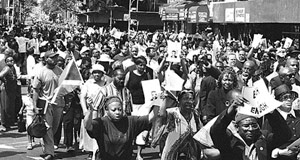
NEW YORK (FinalCall.com) – Hundreds of Brooklyn residents packed into the Emmanuel Baptist Church to talk about how best to deal with the murder of a popular local politician. The word circulating through the church was that this was another “assassination” of a Black leader.
Brooklyn’s 35th District Councilman James Davis, 41, (D-Clinton Hill, Fort Greene, Crown Heights) was shot and killed at 2:08 p.m. on July 23, by a gunman who opened fire during the City Council’s regularly scheduled meeting.
The police identified Mr. Davis’ killer as Othniel Askew, 31, also of Brooklyn, who accompanied the council member to City Hall. Mr. Askew was shot and killed, officials said, by an undercover police officer, Richard Burt, who was guarding Council Speaker Gifford Miller. Mr. Davis had been elected in 2001.
Mr. Askew has been described as a political aspirant, who had talked publicly about running against Mr. Davis in the Democratic primary in September. Police said that after a search of Mr. Askew’s apartment, they found no letter explaining his actions.
People at the town hall meeting said it was time to reflect on what they, as Black people, need to do for their children and themselves in the fight against violence towards each other. One issue that has been most troubling to many in the Black community, according to observers, is that all three men involved in the City Hall tragedy are Black. Many people also commented on how it always seems that popular Black leaders are murdered.
James Davis gave the appearance of being a brother who was locked into the community, Kevin Powell, a community activist told the town hall meeting. “And when someone who seems to care about the community gets killed like Councilman Davis did, it takes on the proportions of a Malcolm or Martin assassination,” Mr. Powell added.
Some observers are saying that, in death, Mr. Davis drew a bigger crowd than he ever did at his annual “Love Yourself: Stop The Violence” rally. Thousands lined up at City Hall on July 25, as Mr. Davis’ coffin lay in state in the rotunda. Thousands more lined the streets as his remains made their final trip to the cemetery. “He definitely wasn’t an outsider,” onlookers said.
Those who attended the town hall meeting had come to vent, to seek answers and to find direction for the future. “I believe the community walked away with the ability to process their pain,” observed April Silver, a community activist and founder of Akila Worksongs, a Brooklyn-based public relations firm. She said the meeting’s organizers were able to provide the names of wellness groups that would help in the healing process. “We also believe that those who attended were given a strong insight into the inner workings of the political process,” Ms. Silver told The Final Call.
Many in the audience said they feared that the murder of Mr. Davis would mean the return of business as usual–a district run by reclusive politicians, who only show up at election time, not an insurgent such as James Davis, who always had time for anyone who approached him.
“Mary Pinkett was our councilperson for 27 years and she never did anything for South Crown Heights,” a merchant said, while watching the funeral procession for the slain councilman. Political insiders say Mr. Davis won over the district by being visible in the projects, where people had been disregarded for too long. “He (Davis) was seen and he was visible. Ms. Pinkett, they never saw,” commented a Black political strategist.
According to New York census figures, 62.7 percent of the 35th Council District is Black and 17 percent is White, with a 16 percent Latino population and Asians at two percent. Seventy-nine percent of the registered voters in the district are Democrats, with Independents comprising the second largest group at 14 percent. There are only four percent enrolled in the Republican Party.
Activists say the district is a microcosm of New York’s political problems. One New York paper described the issues in these words: “The poorest and richest are in a stone’s throw of each other. Low-income residents are priced out of redeveloped apartments, while the residents of the two projects in the district are afraid they are being pushed out by gentrification.”
Observers say that in the two years that Mr. Davis was the councilman, he put a face on those in the district that felt they were being ignored. “He was no revolutionary, but he had a progressive vision,” Elombe Brath of the Patrice Lumumba Coalition told The Final Call.
“James had the vision, he was a new energy, and he fought to have his people at the table,” a Brooklyn community activist told The Final Call, while requesting anonymity. She said the councilman insisted that Blacks share in the multi-million-dollar pot that had come to the district, mostly for redevelopment.
“When he voted against the recent 18 percent real estate tax, he knew that he would be punished by the council speaker, but he said we are losing too much property as it is, and the tax increase means a lot more Black people will lose their homes,” the activist said.
Analysts say it’s hard to assess what Councilman James Davis accomplished, but what is clear is that he made a mark.












